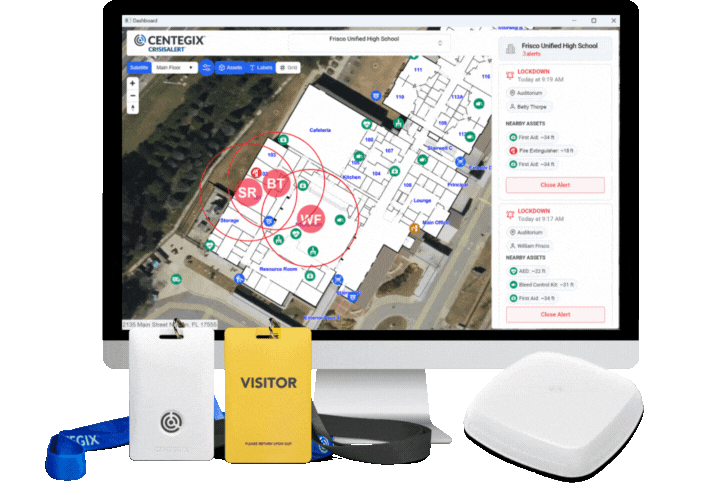American students assert that a safe school environment is crucial to their healthy academic and social development. Research confirms that students’ perception of safety is directly related to their academic achievement. When students feel safe at school, they can fully participate and gain a sense of belonging. Conversely, when students feel unsafe, this negatively impacts their mental health, attendance, tardiness rates, and academic performance. Research shows that students’ sense of safety at school is strongly linked to their attendance, while pervasive safety concerns drive disengagement and chronic absenteeism.
To combat the growing problem of absenteeism, school leaders must invest in school safety solutions that improve students’ perceptions of safety. Multilayered school safety plans that create a culture of safety in schools help districts combat absenteeism and keep staff and students safe.
How Feeling Unsafe Impacts Students
Among students who report feeling unsafe, 15% report staying home from school most or all the time. In contrast, only 3% of students who reported feeling safe in their classrooms stayed home at the same rates.
In addition to missing out on instructional time due to absences, feeling unsafe can make it difficult for students to focus on learning while at school. This inability to concentrate also affects performance on tests; research shows a consistent negative relationship between feeling unsafe in the classroom and test scores.
Feeling unsafe at school can also increase tardiness, cutting class, and student disruptiveness. These behaviors tend to ripple outward from one disruptive student to their peers, which then places additional demands on teachers, who are forced to take time and energy away from teaching to deal with behavioral issues.
The Magnitude of the Problem
A student with chronic absence is defined as missing ten percent or more school days including excused and unexcused absences and suspensions. Chronic absenteeism is a growing problem across the United States. Educators have been aware of this trend for several years: in the 2015-16 school year, over 7 million students missed 15 or more school days. This equates to 16% of the student population or about one in six students.
Test scores have worsened as school districts struggle to recover from learning disruptions during remote schooling. The widespread teacher shortage has led to teacher development and staffing challenges. These problems cannot be disentangled from the chronic absenteeism crisis.
And absenteeism rates are increasing. In the 2020-21 school year, at least 14.7 million students nationwide were chronically absent. Rates of chronic absenteeism, therefore, have almost doubled since pre-COVID rates. The negative impacts of chronic absenteeism include:
- difficulty learning to read by third grade, which correlates to higher high school dropout rates
- low academic achievement in middle and high school
- increased high school dropout rates, which correlate to poor outcomes in adult life, including poverty, diminished health, and involvement in the criminal justice system
When students are absent, they miss more than classroom instruction. Absent students lack access to school meals, mental health support, social communities, and trusted adults. Particularly in communities in which food insecurity, safe transportation, and access to technology are barriers, the supports available at school are critical to students’ physical and mental health.
Absenteeism Affects All Students
When chronic absenteeism rates are high, administrators and staff must address the problem. But in many schools, staff has already reached or exceeded their capacity to serve students effectively. The academic and behavioral challenges that emerged when students returned after COVID-related school shutdowns require concentrated attention and resources. Increased attention to school safety plans can take staff attention away from curriculum and planning. Compounding these challenges with chronic absenteeism further strains teaching staff and school resources. The nationwide teacher shortage exacerbates this combination of challenges.
Under these conditions, even students who attend school regularly are negatively affected. Research shows that as the percentage of absent classmates increases, academic achievement and executive functioning worsen among students in the classroom. Inevitably, the educational experiences of children who attend school regularly can be diminished when teachers divert their attention to meet the learning and social needs of chronically truant children.
The problem disproportionately impacts students who live in poorer communities. These students are four times more likely to be chronically absent than others for reasons beyond their control, including unstable housing, unreliable transportation, and a lack of access to health care.
How Attendance Impacts Outcomes
Chronic absenteeism correlates with a variety of adverse outcomes that affect students throughout their schooling years and beyond.
- Absenteeism in the first month of school can predict poor attendance throughout the school year.
- Poor attendance can influence whether children become proficient readers by the end of third grade or are held back.
- By sixth grade, chronic absence becomes a leading indicator that a student will drop out of high school.
But when attendance rates go up, students’ academic prospects and chances of graduating increase, too. Schools must engage students and parents to improve attendance rates and implement school safety plans that improve student perceptions of safety.
According to Hedy Chang, the founder of Attendance Works, “When you see these high levels of chronic absence, it’s a reflection that the positive conditions of learning that are essential for motivating kids to show up to school have been eroded. It’s a sign that kids aren’t feeling physically and emotionally healthy and safe. Belonging, connection, and support—in addition to the academic challenge and engagement and investments in student and adult well-being—are all so crucial to positive conditions for learning.”
The Relationship Between Safety and Student Mental Health
A student’s sense of safety has a very real impact on their mental health. According to researchers, there is a significant association between mental health difficulties and a sense of safety at school. Feeling unsafe at school is related to depressive symptoms, self-harming behavior, and suicidal behavior in particular. In 2022, 69% of public schools reported an increase in the percentage of their students seeking mental health services at school, and 76% of schools also reported an increase in staff voicing concerns about their students exhibiting symptoms such as depression, anxiety, and trauma.
Conversely, when students feel safe at school, the probability of suicide attempts and suicidal ideation among students decreases. Safe schools help to shield students from the fear or anxiety that can weaken cognitive ability and restrict the learning process.
Students who feel safe achieve higher academic performance. Students who report feeling unsafe are absent more often and score lower on math and English language arts standardized tests. Classroom safety is, therefore, critical to students’ academic success.
Feeling Safe Impacts Student Attitudes
Students’ sense of safety informs their overall feelings about their school. When students view their school positively, they will likely become involved and invested in school life. However, making students feel safe must be undertaken carefully, as some invasive safety measures adversely affect students’ perceptions of safety.
School safety solutions that rely on strengthening school security measures have become a typical preventive response to school violence. For example, metal detectors have been shown to have a negative impact, while closer ties to a school security officer have been associated with higher perceived school safety. “Hardening” a school by increasing safety infrastructure and lockdowns, when not done thoughtfully, can cause trauma that makes students feel less safe and alienates them from school life. For this reason, districts should implement school safety plans featuring layers of proactive and defensive safety measures that create a culture of safety.
CENTEGIX Safety Platform™: Creating a Culture of Safety
CENTEGIX Safety Platform is the foundation for a multilayered approach to safety. The school safety solutions included in the CENTEGIX Safety Platform work together to make campuses safer and provide the support staff and students need to feel safe attending school each day.
- CENTEGIX CrisisAlert™ empowers staff to quickly request the help they need in the event of an emergency. Staff members can press their wearable emergency button to initiate alerts or campus lockdowns. Students feel safer knowing that their teacher can quickly request help and that help will arrive quickly.
- CENTEGIX Safety Blueprint is a dynamic digital mapping tool that directs responders to the precise locations of alerts and school safety assets. Students can be assured that first responders can find the location of the alert and aid them quickly in an emergency.
- Visitor Management tools enable schools to screen all visitors. Enhanced Visitor Management instills confidence that only authorized visitors are present and administrators can locate them on campus in real time.
- After an emergency, reunification tools efficiently reunite students with parents or designated caregivers. This makes students feel safer faster, reducing the risk of trauma.
The CENTEGIX Safety Platform includes school safety solutions that empower staff to respond quickly to emergencies, from the everyday to the extreme. When students know that their school has implemented a multilayered safety plan, their perception of safety improves, allowing them to focus on learning.
Reach out today to schedule a custom demo.












